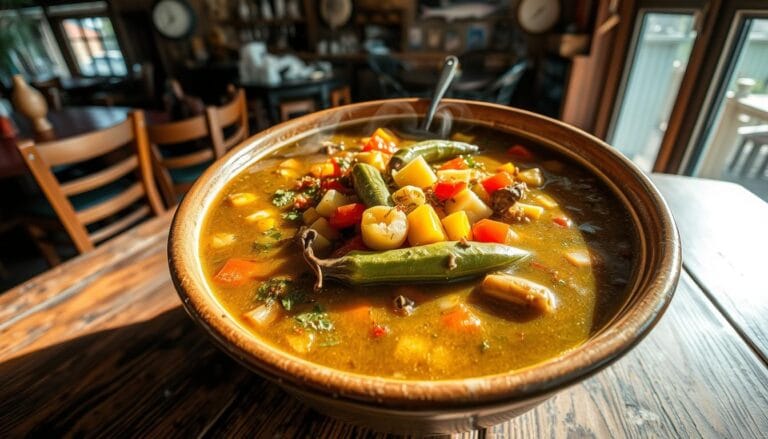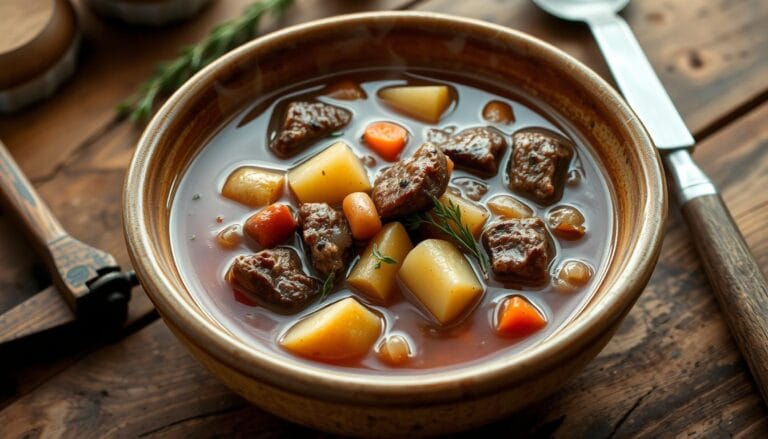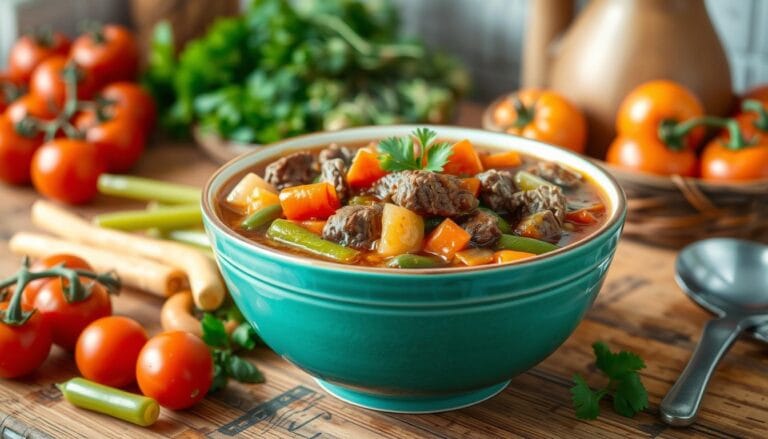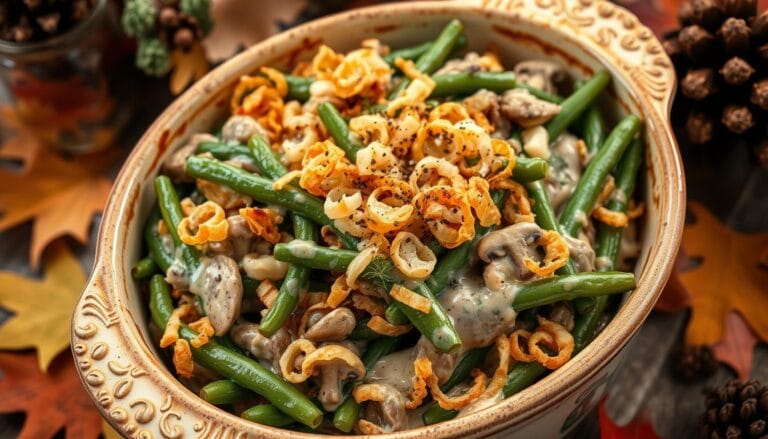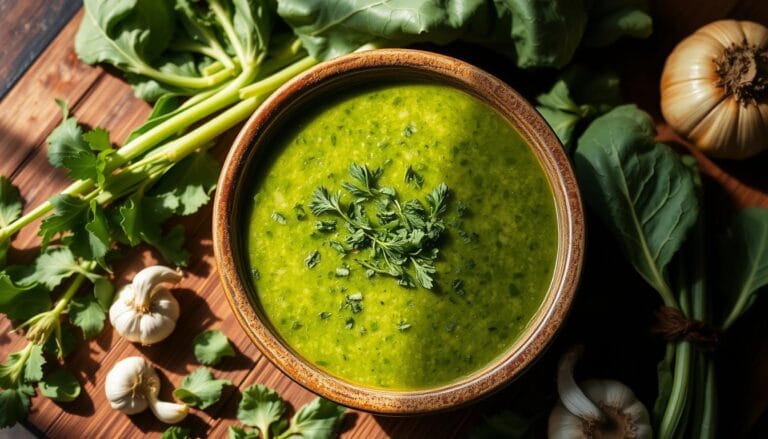How to Make a Pot Pie: Step-by-Step Guide for Beginners
Growing up in my grandmother’s kitchen, the smell of a homemade pot pie was always a sign of comfort and love. Those memories sparked my passion for making this classic comfort food. It’s a dish that brings families together at the dinner table.
Making an easy pot pie might seem hard, but with the right help, anyone can do it. This guide is perfect for beginners or anyone wanting to improve their cooking skills. It will turn your kitchen into a place where pot pies are made with ease.
Pot pies are great because they can be made in many ways. You can make traditional chicken pies or try vegetarian ones. Our guide will help you through every step, making sure your pot pie is a hit with your family.
Get ready for a tasty adventure that’s easy to follow. By the end of this guide, you’ll be able to make pot pies that are as good as those from professional chefs.
Table of Contents
Understanding the Basics of Pot Pie Making
Making a tasty pot pie is all about the basics. You need the right tools and to know how to bake it just right. Every little thing counts to make a dish that’s both comforting and delicious.
Essential Equipment and Tools
Having the right tools is key to a successful pot pie. Here are the essentials:
- 9-inch deep-dish pie plate
- Rolling pin
- Pastry brush
- Sharp kitchen knife
- Large mixing bowl
Key Ingredients Overview
Choosing the best ingredients is vital for a memorable pot pie. Make sure you have:
- Protein (chicken, beef, or vegetables)
- Fresh vegetables
- Flour for thickening
- Heavy cream
- Seasonings
Time and Temperature Guidelines
Getting the baking just right is crucial. Bake at 375°F for 40-45 minutes. This will make the crust golden brown.
“The secret to a great pot pie is patience and precision in your cooking technique.”
| Ingredient | Quantity | Preparation Time |
|---|---|---|
| Chicken | 1 pound | 10-12 minutes |
| Vegetables | 1 pound | 5-8 minutes |
| Broth | 3 cups | Simmering |
Pro tip: Always let your pot pie rest for 10-15 minutes after baking. This lets the filling set and become even more flavorful.
Preparing the Perfect Pie Crust
Making a great pot pie begins with a solid pie crust. You can go for homemade or store-bought. Knowing the differences can make your dish stand out.
Homemade vs. Store-Bought Pie Crust
Homemade pie crust gives you control over taste and texture. Store-bought is quick and easy.
| Homemade Pie Crust | Store-Bought Pie Crust |
|---|---|
| Complete control over ingredients | Instant preparation |
| Fresher taste | Consistent texture |
| Customizable thickness | Uniform appearance |
Crust Rolling Techniques
Rolling out the crust takes practice. Begin on a floured surface. Roll from the center, rotating to keep it even.
- Use cold butter for flakier texture
- Chill dough for 30 minutes before rolling
- Aim for 1/8-inch thickness
- Avoid overworking the dough
Pre-Baking Tips
Pre-baking makes the crust crisp. Heat your oven to 450 degrees Fahrenheit. Bake for 6-8 minutes until it’s golden.
“A perfect pie crust is the secret weapon of every great home cook.” – Professional Chef
Creating the Savory Filling
Making the perfect pot pie filling is an art. It turns simple ingredients into a delicious meal. Your filling is the heart of this classic dish, mixing meat and veggies into a tasty mix.
When making your savory pie, remember these key ingredients for a great filling:
- 3 cups shredded rotisserie chicken
- 2 medium carrots, finely diced
- 3 celery stalks, finely diced
- 2 medium onions, finely diced
- 1½ cups frozen peas
- 2 teaspoons fresh thyme, chopped
Pro tip: The secret to a great filling is cooking your veggies right. Sauté them for 3-4 minutes until they’re soft but still colorful and full of nutrients.
| Ingredient | Quantity | Preparation |
|---|---|---|
| Rotisserie Chicken | 3 cups | Shredded |
| Vegetables | Mixed | Finely diced |
| Fresh Thyme | 2 teaspoons | Chopped |
“A great pot pie filling is all about balance and layering flavors.” – Culinary Expert
For more flavor, add a pinch of turmeric and season with salt and pepper. Your homemade filling will be the highlight of dinner, offering a comforting and tasty meal for all.
How to Make a Pot Pie Soup: Converting Traditional to Liquid
Turning a classic pot pie into a soup is a fun way to get creative in the kitchen. This pot pie soup recipe lets you enjoy the comforting flavors of a traditional pot pie in a liquid form.
To make your favorite pot pie into a liquid version, you need to make some changes. These adjustments help keep the flavor and texture just right.
Adjusting Consistency
For a liquid pot pie, you’ll need to change the filling’s consistency. Here’s what to do:
- Up the liquid by 30-40%
- Start with chicken or vegetable broth
- Go for a thinner texture than the original filling
Seasoning Balance
Seasoning is key to getting the pot pie’s taste right in a soup. Here are some tips:
- Cut dry seasonings by about 25%
- Add fresh herbs for extra flavor
- Adjust seasonings slowly as you taste
Thickening Methods
Getting the soup’s thickness just right is important. Here are some methods to try:
| Thickening Method | Technique | Recommended Use |
|---|---|---|
| Roux | Flour and butter mixture | Classic, rich texture |
| Cornstarch Slurry | Cold water + cornstarch | Quick and gluten-free option |
| Pureed Vegetables | Blend some vegetables into soup | Natural thickening method |
Pro tip: Always add thickeners gradually to control the soup’s final consistency.
“The secret to a perfect pot pie soup is balancing flavor, texture, and creativity.” – Professional Chef
Mastering the Creamy Sauce Base
Making a creamy pot pie sauce is an art. It turns a good dish into an extraordinary one. The secret is in the roux for pot pie, which makes the sauce smooth and rich.
“A perfect sauce is the heart of any memorable pot pie” – Home Cooking Wisdom
To thicken the sauce, start with a classic roux. Follow these steps:
- Melt 6 tablespoons of butter in a heavy-bottomed skillet
- Gradually whisk in 1/3 cup of all-purpose flour
- Cook the mixture for 2-3 minutes to eliminate raw flour taste
- Slowly incorporate 2 cups of chicken stock
- Add 1/2 cup of heavy cream for extra richness
The right technique is key. Whisking constantly and adding liquid slowly helps avoid lumps. This makes your sauce smooth, just like in a restaurant.
| Ingredient | Quantity | Purpose |
|---|---|---|
| Butter | 6 tablespoons | Roux base |
| All-purpose flour | 1/3 cup | Sauce thickening |
| Chicken stock | 2 cups | Liquid base |
| Heavy cream | 1/2 cup | Richness and smoothness |
Add 2 teaspoons of salt and 1/4 teaspoon of black pepper to season. This will make your creamy pot pie sauce a hit. Everyone will want more.
Vegetable Preparation and Cooking Methods
Making a perfect pot pie starts with picking the right vegetables. Knowing how to prep them can make your dish stand out.
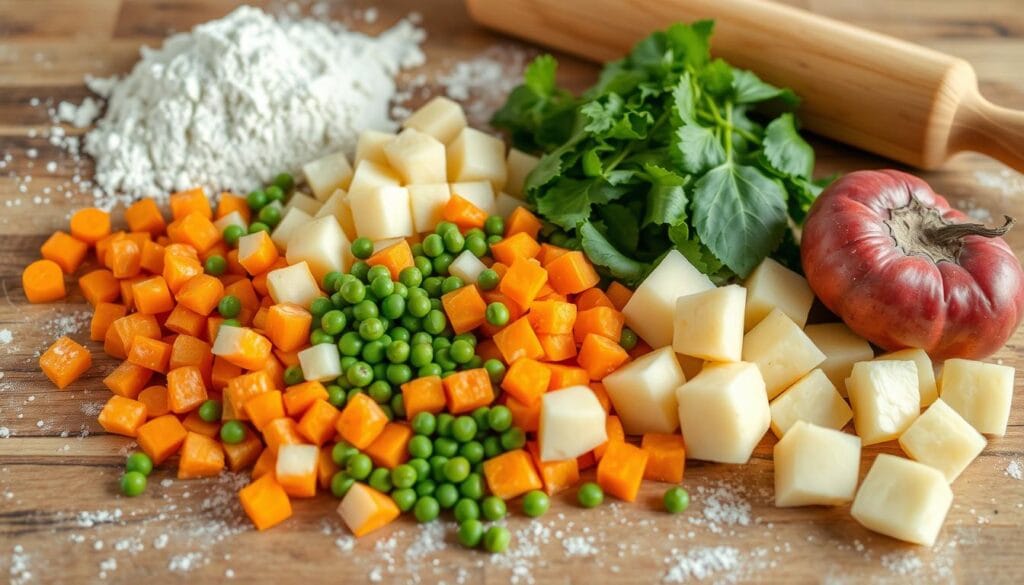
Choosing the right vegetables is key to a tasty and healthy pot pie. Fresh vegetables, which 65% of cooks prefer, add a lot of flavor.
Chopping and Sizing Guide
Getting your vegetables ready right is important for even cooking. Here are some tips:
- Cut vegetables into uniform 1/4 to 1/2 inch pieces
- Aim for consistent sizing to ensure even cooking
- Use sharp knives for clean, precise cuts
Pre-Cooking Requirements
Some veggies need to be cooked before adding them to the pie. Knowing which ones do can make your pie better.
| Vegetable | Pre-Cooking Needed | Recommended Method |
|---|---|---|
| Carrots | Yes | Steam for 3-4 minutes |
| Potatoes | Yes | Parboil for 5 minutes |
| Onions | Optional | Sauté until translucent |
| Peas | No | Add directly to filling |
Best Veggie Combinations
Choosing the right mix of vegetables can make your pot pie unforgettable. Here are some classic combos:
- Carrots, celery, and onions
- Peas, potatoes, and mushrooms
- Broccoli, cauliflower, and carrots
“The secret to a great pot pie is balanced vegetable preparation and thoughtful combination.” – Professional Chef
45% of home cooks find prepping veggies time-consuming. But with these tips, you can make delicious, healthy pot pies faster.
Assembly and Decoration Techniques
Turning your pot pie into a masterpiece needs careful assembly and creative presentation. The right techniques can make your pot pie stand out.
Your decorative pie crust is like a canvas for your creativity. Begin by rolling out the dough evenly. This makes it smooth for your artistic touches.
- Create intricate lattice tops by weaving strips of dough
- Use cookie cutters to make decorative shape cut-outs
- Practice crimping edges for a professional finish
- Experiment with herb-infused pastry for added flavor
Pot pie presentation is more than looks. Here are some techniques to make your dish stunning:
- Brush the crust with egg wash for a golden, glossy finish
- Sprinkle herbs or seeds on top for texture
- Use stencils to create intricate designs
- Layer ingredients strategically for visual appeal
“A beautiful pot pie is art you can eat!” – Professional Chef
| Decoration Technique | Difficulty Level | Visual Impact |
|---|---|---|
| Lattice Crust | Intermediate | High |
| Herb Cut-Outs | Easy | Medium |
| Crimped Edges | Beginner | Medium |
Pro tip: Always ensure your ingredients are cooled before assembling. This prevents a soggy crust and keeps it sturdy.
Baking Tips and Timing Guidelines
Mastering pot pie baking needs precision and detail. Your perfect pie crust comes from knowing key baking techniques. These ensure a golden, crispy outside and a hot, tasty inside.
Temperature Control for Optimal Results
The ideal baking temperature for pot pies is 375-400 degrees Fahrenheit. This range helps cook evenly and prevents soggy crusts. Experts suggest:
- Preheat the oven fully before putting in the pie
- Use an oven thermometer to check the temperature
- Place the pie on the middle rack for even heat
Visual Doneness Indicators
Knowing when your pot pie is done is more than just timing. Look for these signs:
- A deep golden-brown crust color
- Visible bubbling filling around the edges
- Crisp, flaky pastry texture
Troubleshooting Common Baking Challenges
Preventing common baking problems requires planning. Here are fixes for typical pot pie issues:
| Problem | Solution |
|---|---|
| Soggy Bottom | Pre-bake crust for 10 minutes, use egg wash |
| Undercooked Filling | Cover with foil, reduce oven temperature |
| Burnt Edges | Use pie crust shield or aluminum foil |
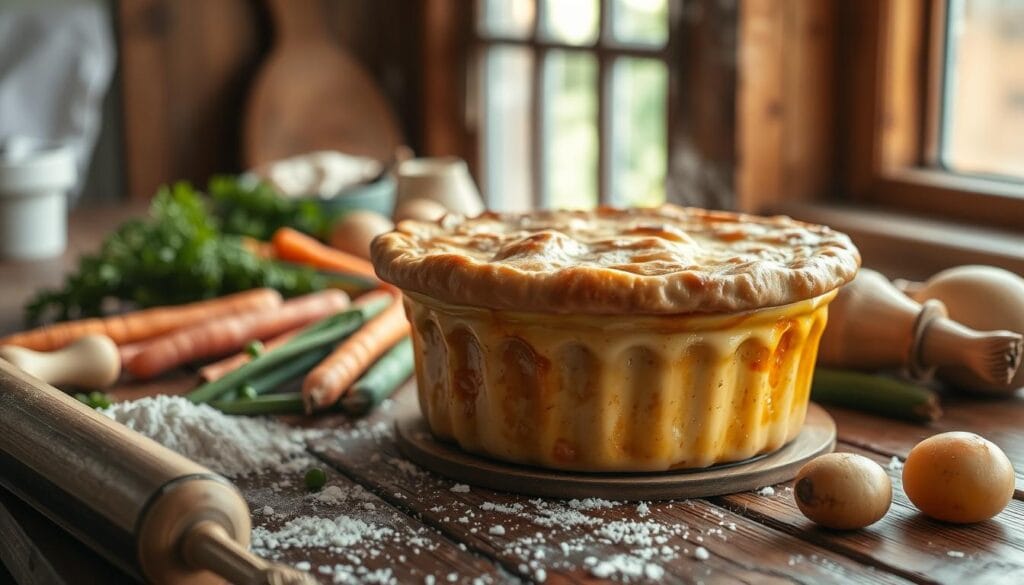
Pro tip: Always let your pot pie rest for 10-15 minutes after baking. This lets the filling set and become stable before serving.
“A perfectly baked pot pie is a symphony of temperature, timing, and technique.” – Culinary Expert
Conclusion
Making the perfect pot pie is an art. It mixes simple ingredients with creative techniques. By trying out different pot pie styles, like turkey or vegetarian, you open up a world of flavors. Your skills will turn this classic dish into a special treat for everyone.
Adding the right touches can make your pot pie even better. Try it with a fresh salad or warm bread. And don’t worry about leftovers. You can keep them in the fridge for a few days or freeze them for months, so you’re always set for a tasty meal.
Practice is key to getting better. Feel free to try new ingredients and cooking methods. Every pot pie you make will teach you something new. Soon, you’ll be a pro at making delicious pot pies.
Your cooking adventure is just starting. Keep trying new things and exploring different pot pie recipes. The kitchen is your place to play and create. Pot pies are just the beginning of your culinary journey.


